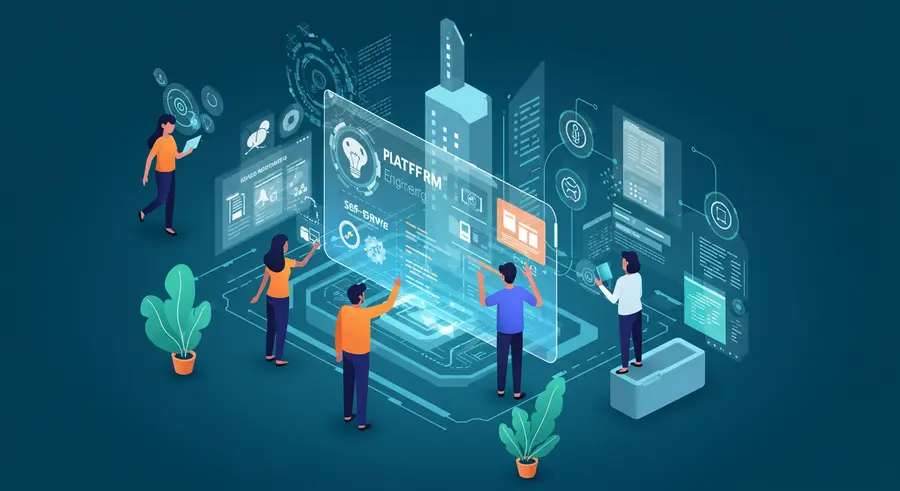Appearance

Welcome, fellow tech enthusiasts and innovators! 👋 Today, we're diving deep into a topic that's rapidly transforming how software is built and delivered: Platform Engineering. If you've ever felt the friction of complex development environments, the burden of managing infrastructure, or the slowdown caused by scattered tools, then platform engineering might just be the solution you've been looking for.
What Exactly is Platform Engineering? 🤔
At its core, Platform Engineering is the discipline of designing and building internal developer platforms (IDPs) that provide self-service capabilities for software engineering organizations. Think of it as creating a paved road for developers, abstracting away the underlying complexities of infrastructure, tools, and processes. Instead of each development team reinventing the wheel for deployments, monitoring, or security, a platform team provides a cohesive, integrated environment that streamlines these operations.
This doesn't mean developers lose control or understanding of the underlying systems. Rather, it empowers them to focus on what they do best: writing application code and delivering features, without getting bogged down in operational overhead.
Why the Buzz Around Platform Engineering? 📈
In today's fast-paced digital landscape, organizations need to innovate rapidly. Traditional DevOps models, while effective, often lead to a high cognitive load for developers who are expected to be experts in both application development and operations. This is where platform engineering shines:
- Increased Developer Productivity & Happiness: By providing self-service tools and automated workflows, developers can deploy code faster, troubleshoot issues more efficiently, and spend less time on repetitive tasks. This leads to happier, more productive teams.
- Consistency and Standardization: Platforms enforce best practices, security policies, and architectural patterns across the organization. This reduces inconsistencies, improves code quality, and simplifies auditing.
- Faster Time-to-Market: With streamlined processes and automated infrastructure, new features and applications can be delivered to users much quicker.
- Reduced Cognitive Load: Developers no longer need to be experts in every operational aspect. The platform handles the underlying complexities, allowing them to focus on business logic.
- Improved Security and Compliance: Security and compliance guardrails can be built directly into the platform, ensuring that all deployments adhere to organizational standards from the start.
- Cost Optimization: By standardizing infrastructure and automating deployments, organizations can optimize resource utilization and reduce operational costs.
Platform Engineering vs. DevOps vs. SRE: What's the Difference? 🔄
It's easy to confuse these terms, as they are all related to improving software delivery. However, they have distinct focuses:
- DevOps (Development Operations): A cultural and professional movement that emphasizes communication, collaboration, integration, and automation to improve the flow of work between development and operations teams. It's about breaking down silos.
- SRE (Site Reliability Engineering): A discipline that applies software engineering principles to operations. SRE aims to create highly reliable and scalable systems by focusing on metrics, automation, and reducing toil.
- Platform Engineering: Focuses on building and maintaining the tools and platforms that enable DevOps and SRE principles to be effectively implemented at scale. It provides the "paved road" that developers use.
In essence, platform engineering enables DevOps and SRE by providing the necessary infrastructure and tools, making it easier for development and operations teams to collaborate and achieve their goals.
Key Components of an Internal Developer Platform (IDP) 🛠️
A robust IDP typically includes:
- Infrastructure as Code (IaC): Tools like Terraform or Pulumi to define and manage infrastructure.
- Containerization & Orchestration: Docker and Kubernetes are almost synonymous with modern platforms, providing portability and scalability.
- CI/CD Pipelines: Automated pipelines for building, testing, and deploying applications (e.g., GitLab CI, GitHub Actions, Jenkins).
- Observability Tools: Centralized logging, monitoring, and tracing (e.g., Prometheus, Grafana, ELK Stack, Jaeger) to provide insights into system health and performance.
- Service Catalogs: A self-service portal where developers can discover, provision, and manage various services and resources.
- Developer Portals: A single pane of glass for developers to access documentation, tools, and dashboards.
- Security & Compliance Integrations: Baked-in security scanning, policy enforcement, and compliance checks.
Real-World Success Stories 🌟
Many leading tech companies have successfully implemented platform engineering principles to scale their operations and empower their developers:
- Spotify with Backstage: Spotify's developer portal, Backstage, is a prime example of a successful IDP. It provides a centralized hub for developers to manage their services, discover components, and access documentation, significantly improving developer experience and productivity.
- Netflix: A pioneer in cloud-native and microservices architectures, Netflix has heavily invested in platform engineering to provide its engineering teams with self-service tools for deploying, monitoring, and scaling their applications. This has enabled them to innovate at an incredible pace.
These examples highlight how platform engineering can lead to significant improvements in efficiency, reliability, and developer satisfaction.
Getting Started with Platform Engineering 🚦
If you're considering adopting platform engineering, here are some key steps:
- Start Small, Think Big: Don't try to build the ultimate platform overnight. Begin with a minimum viable platform (MVP) that addresses the most pressing pain points for your developers.
- Focus on Developer Experience: The primary goal is to make developers' lives easier. Involve them in the design and feedback process.
- Treat the Platform as a Product: Just like any other product, your internal developer platform needs a clear vision, roadmap, and dedicated team.
- Automate Everything Possible: From infrastructure provisioning to deployments and monitoring, automate repetitive tasks to reduce manual errors and increase speed.
- Foster a Culture of Collaboration: Platform engineering requires close collaboration between platform teams, development teams, and operations.
Conclusion: The Future is Platform-Driven 🚀
Platform engineering is not just a trend; it's a strategic imperative for organizations looking to thrive in the cloud-native era. By building robust internal developer platforms, companies can unlock unprecedented levels of developer velocity, improve system reliability, and accelerate their journey towards digital excellence.
If you're eager to learn more about this topic, be sure to check out the related content on Platform Engineering: Building Developer Self-Service.
Happy platform building! 🏗️